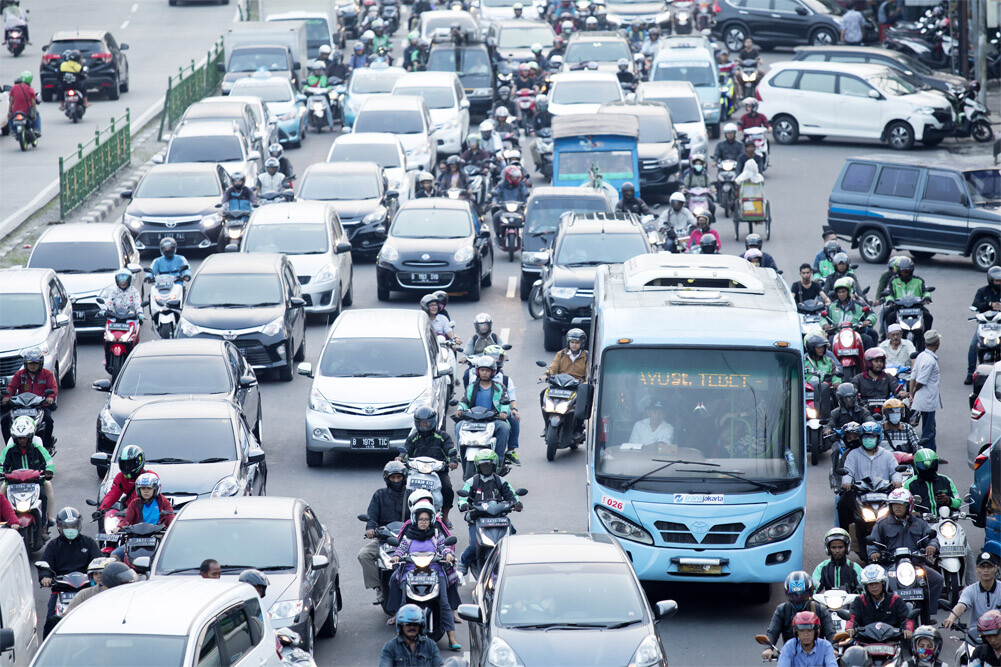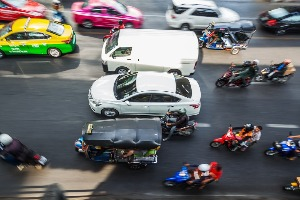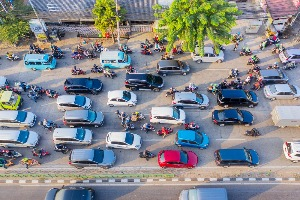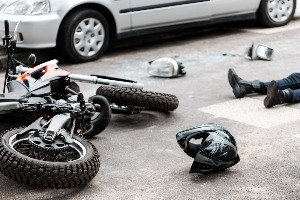
IS LANE SPLITTING LEGAL IN CALIFORNIA?
Lane splitting is legal in California, but only if done in a safe and prudent manner. There have been many discussions regarding the safety and legality of lane splitting, and many people wonder why and how this was allowed in the first place. Looking at how motorcycles traverse highways and main roads by lane splitting, there can be risks that can prove hazardous to motorcyclists and sometimes other drivers on the road.
Before making any judgments and looking past the initial idea of splitting lanes, one should know what it is and how it is beneficial to motorcycle riders. At the end of this article, we hope to enlighten you on this topic by answering the question, “Is Lane Splitting Legal in California?”
California is the only state in the US that has legalized the act of splitting lanes. Motorcyclists can travel faster than other vehicles in heavy traffic conditions by lane splitting. Other states may follow suit, but as of now, it is legal only in California. This act of legalizing lane splitting benefitted motorcyclists in a great way because of the increasing number of motorcycles on Californian roads. Motorcycle riders can now bypass heavy traffic, save time and even reduce the risk for injuries in case of an accident.
There will be no liability for motorcyclists by the mere act of splitting lanes since the law only stated that it should be done in a safe and prudent manner. The motorcycle riders are not given absolute freedom to split lanes in any way they see fit because doing so can endanger their lives and the lives of other people on the road. To be legal does not mean not have any restrictions.
Table of Contents
WHAT IS LANE SPLITTING?
You may be a motorcycle owner. You are late for work, and there’s the never-ending traffic during the rush hour on the Los Angeles freeway. You want to find a quicker way to go to your office without endangering yourself and others. You may consider the option of splitting lanes.
A motorbike weaving through traffic at a red light or rocketing past automobiles on the highway is the usual scene most think of when the term lane splitting is mentioned. This visual is common among California drivers. LA traffic is famous for being a mess, and lane splitting is often the quickest way to get from points A to B, which is true in most cities in California.
Assembly No. 51 of California Law provides for the legal definition of Lane Splitting. Lane Splitting is driving a 2-wheel motorcycle on the road between stopped or moving vehicles in the same lane, as specified. Lane splitting is different from lane sharing, defined as driving a 2-wheel motorcycle alongside and away from moving or stationary vehicles in the same lane, as specified. Because of the nature of motorcycles having two wheels and maneuver around cars, lane splitting is allowed for these motorcycles to help prevent traffic congestion.
Motorcycles do not fall in line in stand-still traffic and are instead weaving through the traffic. This can be advantageous for them since they’re not obliged to fully stop and wait for traffic to move. Assembly No. 52 also authorized the Department of California Highway Patrol to issue guidelines regarding the safe way of lane splitting.
CALIFORNIA LANE SPLITTING LAWS

As mentioned earlier, the basis of legalizing lane splitting is Assembly No. 51. The said law also provided for the definition of lane splitting and authorized the California Department of Highway Patrol to issue educational guidelines that motorists and other drivers will follow. The subsequently issued guidelines were given to provide a detailed description of the rules and regulations governing lane splitting.
The guidelines include the following:
- Lane-splitting becomes dangerous when done at higher speeds. Obey posted speed limits.
- It’s best to split between the left-side lanes on roads with three or more lanes.
- Avoid lane splitting near large vehicles, such as tractor-trailers and buses.
- Avoid the vehicles’ blind spots. The blind spots include the area beside and behind large vehicles.
- During the day, use high beams to make yourself more visible. Wear bright colors or reflective clothing and shine your headlights at nighttime.
Riding on the shoulder of a road is illegal in California and is not considered lane splitting. Always be on the lookout for other vehicles that may block your way as you move between lanes. Drivers and motorcyclists who violate these guidelines will be cited and punished by law enforcement officers. Lane splitting road rage can be avoided by being on the road and following the set guidelines.
WHY DOES CALIFORNIA ALLOW LANE SPLITTING?
Many wonder what made lane splitting legal in California. This is a question that comes up a lot. Here is some information that we hope will help you understand why lane splitting is legal in California and how it can be made safer.
There have been studies that prove lane splitting to be a safe way to drive and reduce traffic and road accidents when done by following a set of guidelines. Of course, there are risks involved, and that is why the CHP released the guidelines. The best way to keep you and other commuters safe is for motorcyclists to follow the guidelines that the CHP has suggested while they are lane splitting.
Long traffic jams are a regular occurrence on busy California freeways. Lane Splitting reduces traffic buildup on the roads by taking advantage of empty spaces between stopped cars or moving slowly.
Lane splitting appears to be more dangerous than moving at a steady speed, but these dangers can be minimized if motorcyclists drive between cars that are going the same direction as they are. Through this, there can be economic benefits to the state as well. Workers who are motorcycle riders will spend less time on the road and more time working on their jobs.
IS LANE SPLITTING SAFE?

Lane splitting safety is one of the biggest questions that come up about this topic. As always, rules vary around the world, but California is unique in allowing motorcycles to split lanes.
Lane splitting will not be allowed without guidelines established by the California Highway Patrol. These guidelines were drafted pursuant to consultations made with experts and different stakeholders. There are still risks, but if all road users are mindful, the risk of accidents will be lesser. There will be a more efficient use of the roads, and this can help increase the productivity of workplaces.
Visibility, correct speed, and spatial distance are critical factors for the safety of motorcyclists. Motorcycle lane splitting safety guidelines must be followed as a way of respecting the riders.
Lane splitting is even safer through the cooperation of other vehicle riders. Motorcycle safety guidelines are important, but the most important of all is to promote road sharing. Splitting lanes will be a small sacrifice to make to have a more efficient highway.
MOTORCYCLE LANE SPLITTING SAFETY MEASURES
The California Highway Patrol, in conjunction with the California Office of Traffic Safety (OTS), will provide technical assistance and public outreach to help address concerns on Motorcycle Lane Splitting.
Motorcycles are not the only stakeholders in lane splitting. The surrounding vehicles should also be careful to avoid a collision, especially in tight spaces.
The following are lane-splitting safety measures for motorcycle riders:
- The motorcycle rider must obey all California Vehicle Code (CVC) rules and regulations, including speed limits.
- A motorcyclist shall not split lanes when traffic is moving at a speed of 30 miles per hour or greater.
- Lane splitting shall not be performed by the rider of a motorcycle when another vehicle is directly adjacent to their motorcycle.
- The rider of a motorcycle must be competent enough to know and understand their limitations, experience, and skill set.
- Motorcycles should always yield to all other vehicles, including other motorcycles.
- Lane splitting should only occur in available gaps and never in an actual traffic lane. Motorcycle riders should be visible and predictable at all times, wear appropriate protective clothing, and always wear the appropriate helmet and other safety gear is recommended.
- Signal lights and loud horns are beneficial when sharing the lane.
It is important for motorcyclists to have a safe motorcycle riding strategy to eliminate the chances of accidents happening. Other vehicles also have the duty to follow traffic rules and regulations. Negligent acts on the road, such as intentionally blocking passing motorcyclists, will pose harm to the rider and everyone else on the road.
EFFECTS OF LANE SPLITTING ON YOUR MOTORCYCLE ACCIDENT CLAIM

Lane splitting is most often done in heavy traffic when the vehicles are moving at a very slow speed, but it can also be performed over faster roads. Despite observing the safety protocols and taking caution on the road, motorcycle accidents can still happen. Motorcycle riders are at a disadvantage because of the nature of their vehicle and for having less protection.
In a motorcycle accident claim, the motorcycle rider has the responsibility to prove that the accident was not his fault. And if it is proven that you are at fault, then your claim will be dismissed.
To bolster your motorcycle accident claim, you have to prove that you observed all the guidelines issued by the Department of California Highway Patrol. The speed limit, the protective gears, and your visibility in the area can help you prove that you are not at fault. This shifts the burden to other vehicle drivers involved in the accident.
A California motorcycle accident attorney can help you further establish your claim and recover compensation for the injuries you sustained. A lane-splitting motorcyclist in California has every right to recover damages from the driver at fault, proven to have exercised extreme caution.
ARE THERE ANY OTHER US STATES THAT LEGALIZE LANE SPLITTING?
None. Lane splitting in California is legal, and it is the only state in the entire United States that allows it. Others States may relax their rules, but in case of accident claims, motorcyclists do not have any remedy if they are injured.
In California, lane splitting is entirely legal, and the CVC specifically allows motorcyclists to pass a stopped or slower-moving vehicle. Motorcyclists may legally travel between two lanes, as long as they do it safely. A few exceptions exist, such as if traffic is moving at less than 30 mph or if weather conditions make it dangerous to do so.
Lane splitting in California benefitted many motorcycle riders since the state is fairly known for traffic jams. It is advised, however, to only do it if traffic flow allows for safe passage between lanes.
IS LANE SPLITTING LEGAL IN CALIFORNIA IN 2020?
Lane splitting is legal in California in 2020 and beyond. Motorcyclists do not have to worry about not splitting lanes as long as they follow all other California laws and the rules of the road. Each city or county can make additional guidelines or rules if they are not covered in the California Vehicle Code.
Assembly No. 51 was signed into law by Governor Jerry Brown in 2016. AN 51 will continue to take effect unless it is repealed by another law disallowing lane splitting. As long as this law is in effect, motorcyclists can do lane splitting as long as they follow the educational guidelines.
This is breakthrough legislation in the United States. No other state or county has these guidelines in place to ensure that motorcyclists are safe. The legalization of lane splitting increased the number of motorcyclists on the roadway. This led to the increase of awareness programs for drivers on the road.
IS LANE SPLITTING STATISTICALLY SAFER?

Since the passing of the law allowing splitting lanes in California in 2016, there have been a number of articles, news reports, and blog posts written about the safety implications of lane splitting. While this article does not review all of those sources, it’s interesting to note that all but one have concluded that lane splitting is a relatively safe practice – even when compared with other motorcycling activities.
The California Office for Traffic Safety (OTS) provides for the number of motorcyclist deaths from not wearing a helmet decreased 18% from 34 in 2018 to 28 in 2019. Overall, Motorcycle fatalities decreased 9.4% from 523 in 2018 to 474 in 2019. The data did not provide for the usual causes of accidents aside from not wearing a helmet.
Thus, the numbers regarding the safety of lane splitting are yet to be released. But we know that as long as there are guidelines that motorcyclists will strictly follow, then the likelihood of accidents will be minimal.
It’s important that we help raise awareness about lane splitting by being responsible riders.
ARE YOU INJURED IN A LANE-SPLITTING ACCIDENT? CONTACT DANESHRAD LAW PC TODAY
At Daneshrad Law, we provide legal assistance and representation to injured victims in a lane-splitting accident. Do not worry about the cost of hiring an attorney, as we offer a free consultation to discuss your case and develop any legal options you may have. We understand the stress and frustration that comes with dealing with injuries, medical bills, and other problems caused by someone else’s negligence.
Contact us at (888) 881-3529 to schedule an appointment for a free consultation. There is no payment upfront upon consulting with us regarding your lane splitting accident. We will evaluate the merits of your case, the injuries you sustained, and other pieces of evidence to determine if you have a case.
Alleviate yourself from worrying about how you will pay for medical expenses and whether or not your injuries will keep you from working. We will be in charge of all your dealings and negotiations with insurance companies, hospitals, and even the police department to ensure that we provide justice for you and your loved ones.

